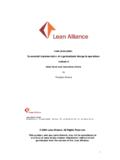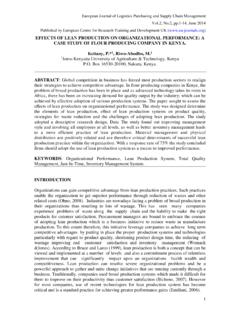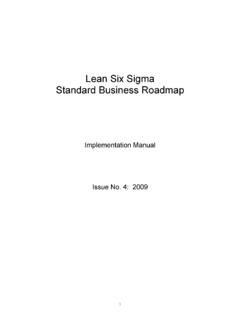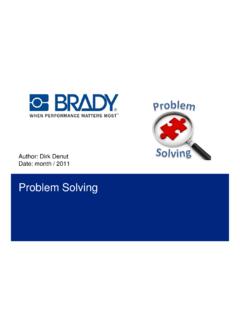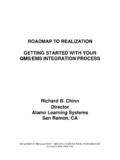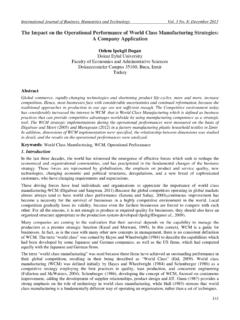Transcription of WASTE MEASUREMENT TECHNIQUES FOR LEAN …
1 WASTE MEASUREMENT TECHNIQUES FOR lean companies Maciej Pie kowski PhD student Wroc aw University of Economics Komandorska 118/120, Wroc aw, Poland A B S T R A C T K E Y W O R D S A R T I C L E I N F O WASTE MEASUREMENT , lean manufacturing, lean metrics Received 07 June 2014 Accepted 17 June 2014 Available online1 December 2014 The paper is dedicated to answer the problem of measuring WASTE in companies , which are implementing lean Manufacturing concept. Lack of complex identification, quantification an visualization of WASTE significantly impedes lean transformation efforts. This problem can be solved by a careful investigation of Muda, Muri and Mura, which represent the essence of WASTE in the Toyota Production System. Measuring them facilitates complete and permanent elimination of WASTE in processes. The paper introduces a suggestion of methodology, which should enable company to quantify and visualize WASTE at a shop floor level.
2 _____ 1. Introduction lean Management, originated from the Toyota Production System, is nowadays one of the most dominating management philosophies, both in industrial and service environment. One of the reasons for such a success is its simplicity. The whole concept is based on a common sense idea of so called WASTE . Removing it is the very essence of lean Management. Despite seemingly simple principles, eliminating WASTE is not an easy task. Many companies , even those with many years of lean experience, still struggle to clear the WASTE out of their processes. It turns out, that the most difficult part is not removing WASTE itself, but identifying and highlighting it, which should precede the process of elimination. This issues can be overcome by implementing a proper WASTE MEASUREMENT system. There are three main conditions for effectively working WASTE MEASUREMENT system: MACIEJ PIE KOWSKI, International Journal of lean Thinking Volume 5, Issue 1(December 2014) 2 Complex WASTE identification, which facilitates elimination of root causes of WASTE , not only symptoms.
3 Putting emphasis only on visible issues, leads to the situation, where achieved improvements are temporary and the problems are back over time. Using quantified WASTE metrics, which allow proper control of a process. Calculating them helps with monitoring and highlighting all problems and defects within a process. It also enables company to compare the results from different areas. Developing response standards for all detected problems, which supports and accelerates decision making process. Properly introduced standards should ensure careful analysis of a root cause and quick implementation of mistake-proofing solutions. Failure to meet this conditions drastically decreases company s ability to eliminate WASTE . The goal of this paper is to present solutions, which will help companies to develop a complex, quantified and standardized WASTE MEASUREMENT system. According to the points above, the first condition to achieve such a system is to identify what the actual WASTE is.
4 2. COMPLEX WASTE IDENTIFICATION What is WASTE In relation to lean Manufacturing, WASTE is often described as Muda - an activity, which does not add value to the product. In other words, it is every action done by a company, which a customer is not willing to pay for. For many lean practitioner, this simple definition is the only beacon in the battle against WASTE . However, it is often forgotten, that according to the Toyota original concept, Muda does not cover the whole essence of WASTE , as it describes only what is visible on the surface of processes. To see the bigger picture, it is necessary to look deeper into a value stream. Under Toyota theory, WASTE is recognized as all factors, which prevent a company from achieving a perfectly efficient production system. In lean Manufacturing, this perfection has a form of the Just-in-Time one of two pillars of the Toyota Production System. Just-in-Time is a concept based on making only what is needed, when it is needed, and in the amount needed.
5 The ultimate goal of this system is therefore to ensure that the right product will be produced by the exactly right amount of man, material and machines and will be deliver to the customer at the right time. Everything, which stands on a way to accomplish it, is considered as WASTE . This broader approach makes it possible to identify all occurrences, which has negative affect on a company. 1 Toyota recognizes three main types of WASTE - Mura (eng. unevenness), Muri (eng. overburden) and already mentioned Muda (eng. WASTE ). All three Mu s are strongly connected with each other and together define Japanese understanding of WASTE . How do these seemingly separated terms form a coherent theory, which strongly contributed 1 MACIEJ PIE KOWSKI, International Journal of lean Thinking Volume 5, Issue 1(December 2014) 3 to the success of the Toyota Production System? Let s take a closer look at each of them.
6 The three types of WASTE Muda, Mura, Mura Muda Muda means WASTE or uselessness. As mentioned in the previous chapter, Muda refers to WASTE of unnecessary activities. This type of WASTE is characterized by using time, money and resources, while not adding any value to the customer. The goal of identifying Muda is to recognize which steps are necessary to the process and which need to be reduced or eliminated. There are seven, tradictional types of Muda: 2 1. Overproduction - producing ahead of what s actually needed by the next process or customer. The worst form of Muda because it contributes to the other six. 2. Waiting - operators standing idle as machines cycle, equipment fails, needed parts fail to arrive, etc. 3. Conveyance - moving parts and products unnecessarily, such as from a processing step to a warehouse to a subsequent processing step when the second step instead could be located immediately adjacent to the first step.
7 4. Overprocessing - performing unnecessary or incorrect processing, typically from poor tool or product design. 5. Inventory handling unnecessary stocks, which results other types of Muda like waiting, correcting and overprocessing. 6. Motion making movements that are wasteful or unnecessary, such as looking for parts, tools, documents, etc. 7. Correction inspecting production to find defects, rework of defected materials. WASTE in a form of Muda directly disturbs implementation of the Just-in-Time system. Muda makes it impossible to reach the goal of using only these resources, which are absolutely needed. Due to wasteful activities, company unnecessarily loses material and energy of both man and machines. Muda causes also losses in time, aggravating deliverance of product at the right time. Therefore, it is safe to say, that non-value added activities are one of the biggest sources (although not the only ones) of WASTE in lean Management.
8 Muri Muri means overburden or unreasonableness. It is associated with WASTE of overloading equipment, facility or people resources beyond its capacity. The overload puts employees and machines into unnecessary stress, reducing their ability to perform. Muri can be also identified as the exact opposite of overburden the underutilization of man and equipment, which causes long periods of idle time. There are three main causes of Muri: 2 lean Lexicon MACIEJ PIE KOWSKI, International Journal of lean Thinking Volume 5, Issue 1(December 2014) 4 1. Poorly organized workstation improperly designed lay-out, which forces employees to put much more effort into ordinary activities than necessary. 2. Lack of standardized work problems with sustaining 5S, unclear instructions and poor communication, which lead to overburden of employees. Similarly, Muri of equipment can be created by lack of maintenance standards and inappropriate utilization.
9 3. Mura - variation in production volume, which will be describe in next paragraph. This excessive stress of people and machines may result in defects and delays of the process. Muri is also common cause of breakdown when it comes to machines, and absenteeism when it comes to people. Therefore, overburden hinders company from achieving goals of the Just-in-Time system by preventing man and machines from operating at 100% of its capabilities. Muri of underutilization of man and equipment has also negative consequences for a company. Similarly as for overburden, this kind of WASTE creates loses in potential capabilities of people and machines. By causing long periods of idle time, all resources are not properly utilized. Mura Mura means variation or unevenness. It refers to WASTE of unevenness in production volume. It may take two different forms: Variation in production scheduling, Uneven production workload and pace of work.
10 One of main causes of Mura is the batch logic, represented by many companies . The philosophy of producing in big batches aims at maximizing utilization of key resources and minimizing cost per unit. It creates however problems with flexibility, hindering company s ability to react to constant changes of customer demand. Batch organizations , in order to protect themselves from the variation in demand, often build a buffer stock, producing more units than necessary. By trying to compensate the variation, they unintentionally increase an actual fluctuation in a production volume. As a consequence, the further a process is from a root of the fluctuation, the bigger unevenness in production volume. This phenomenon is called the bull-whip effect a situation where a small variation in demand at the end of the value stream (customer) leads to high changes in production volume in the earlier stages (production processes).


